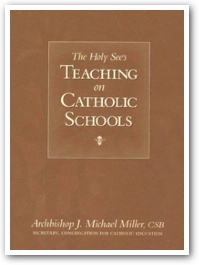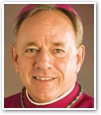The Current Situation of America's Catholic Schools
- THE MOST REVEREND J. MICHAEL MILLER, CSB
Certainly there is much to applaud in the American Catholic school system that currently enrolls almost 2.5 million students in its primary and secondary schools.
Introduction
 |
On September 15, 2005, the Solidarity Association sponsored a conference in Washington that brought together leaders with a passionate interest in the future of Catholic education in our nation. After intense discussion, they concluded that, forty years after the promulgation of the Second Vatican Ecumenical Council's Declaration on Christian Education, Gravissimum Educationis, the signs of the times require that new wine be poured into the wineskins of America's Catholic schools. Affirming the June 2005 statement of the American bishops, Renewing Our Commitment to Catholic Elementary and Secondary Schools in the Third Millennium, the participants committed themselves to ensuring that "truly Catholic" elementary and secondary schools be "available, accessible, and affordable, to all Catholic parents and their children."
The meeting acknowledged the irreplaceable role that Catholic schools play in the new evangelization of America and sought to foster the cooperation of all those involved in this apostolic work. The duty of educating the young is an ecclesial responsibility shared by all members of the Body of Christ: bishops, teachers, parents, and concerned lay leaders.
By her very nature, the Church has the right and the obligation to proclaim the Gospel to all nations (cf. Matt. 28:20). In the words of Vatican II's Gravissimum Educationis:
To fulfill the mandate she has received from her divine founder of proclaiming the mystery of salvation to all men and of restoring all things in Christ, Holy Mother the Church must be concerned with the whole of man's life, even the secular part of it, insofar as it has a bearing on his heavenly calling. Therefore, she has a role in the progress and development of education.
Catholic schools participate in the Church's evangelizing mission of bringing the gospel to the ends of the earth. Particularly, they are places for the evangelization of the young. As ecclesial institutions, they are "the privileged environment in which Christian education is carried out." Like Catholic colleges and universities, Catholic schools proceed ex corde Ecclesiae, from the very heart of the Church. America's Catholic schools, if they are to be genuinely Catholic, must be integrated into the organic pastoral program of the parish, the diocese, and the universal Church.
From the days of their first appearance in the United States, Catholic schools have generously served the needs of the socially and economically disadvantaged. The parochial school system has integrated millions of young Catholics into ecclesial and social life. The Solidarity Association, whose name recalls the heritage of our beloved Pope John Paul II, follows in the long tradition of St. Angela Merici, St. Elizabeth Ann Seton, St. Marguerite Bourgeoys, St. Jean Baptiste de la Salle, St. John Bosco, and countless other religious and lay people who generously dedicated themselves to Christ's love for the poor, the disadvantaged, and the marginalized, as well as for the wealthy and for middle-and working-class Catholics.
This booklet, based on my intervention at the conference sponsored by the Solidarity Association, deals with the Holy See's teaching on Catholic education. Although this theme is far too vast to be adequately summarized in a few pages, I will introduce the major concerns found in post-conciliar Vatican publications on the subject. These include various papal interventions, the 1983 Code of Canon Law in its section on schools, and the five major documents published by the Congregation for Catholic Education since Vatican II: The Catholic School (1977); Lay Catholics in Schools: Witnesses to Faith (1982); The Religious Dimension of Education in a Catholic School (1988); The Catholic School on the Threshold of the Third Millennium (1997); and Consecrated Persons and Their Mission in Schools: Reflections and Guidelines (2002). Among these documents, in particular I recommend for further study The Catholic School and The Religious Dimension of Education in a Catholic School.
After a preliminary statistical look at the current situation, I will discuss parental and government rights in education and the five benchmarks that can be used to judge a school's Catholic identity and thereby take the steps necessary to strengthen it.
The Current Situation of America's Catholic Schools
Sober Statistics
By any measure this is an outstanding testimony to the vigor of Catholic life in the United States.
Even so, we cannot hide the fact that the number of students in Catholic schools continues to decline. The peak was reached in 1965 when 5.5 million students were enrolled in Catholic elementary and high schools. In 1930, there were more Catholic elementary schools (7,225), with 2.5 million students, than in 2004 (6,574), with 1.78 million students. Moreover, in the same seventy-five-year period, the Catholic population tripled: from 20.2 million in 1930 to over 66 million in 2004.
Since 1990, more than 400 new Catholic schools have opened in the United States. But during that period there has been a net loss of more than 760 Catholic schools. Most of the decline has been concentrated in urban, inner city, and rural areas.
Clearly the Church in America is facing a serious challenge in serving her children and young people, one that cannot be swept under the rug or dismissed as the inevitable result of an increasingly secularized society.
From Religious to Lay Leadership
In the past forty years, not only in the United States but also in most of the developed world, religious vocations have plummeted. In 1965, there were 180,000 religious sisters in the United States; today there are fewer than 75,000, of whom more than 50 percent are over seventy years of age. Moreover, in 1965 there were 3.95 sisters for every 1,000 Catholics; in 2002, there was 1.16.
Since Vatican II, Catholic elementary and secondary schools have shown a steady decline in the number of religious and priests who are administrators and teachers, and an increase in the number of laypersons who fill those positions. Today religious women constitute less that 4 percent of the full-time professional staff of Catholic schools, while 95 percent of the teachers are laypersons.
For generations religious women provided the backbone of the parochial school system in the United States, contributing to its establishment and allowing it to flourish by their generous and sacrificial apostolate. In its documents, the Holy See frequently extols the specific contribution made by religious to the Church's educational apostolate:
Because of their special consecration, their particular experience of the gifts of the Spirit, their constant listening to the word of God, their practice of discernment, their rich heritage of pedagogical traditions built up since the establishment of their Institute, and their profound grasp of spiritual truth [cf. Eph. 2:17], consecrated persons are able to be especially effective in educational activities and to offer a specific contribution to the work of other educators.
Undoubtedly, for years, the presence of religious in most parochial and secondary schools served as a built-in guarantee of their Catholic identity, which parents and pastors took for granted. And the vast network of schools established did indeed provide a sound religious and academic education, especially for Catholic immigrant children. The shift to lay leadership in Catholic schools, which has followed from the dearth of religious, presents its own set of challenges.
In no way do I wish to suggest that the laity are somehow second-best as Catholic educators. Still, theirs is a new responsibility and presents a new opportunity for the Church, one full of promise and hope. They, too, have a "supernatural vocation" as educators.
To be effective bearers of the Church's educational tradition, however, laypersons who teach in Catholic schools need a "religious formation that is equal to their general, cultural, and, most especially, professional formation." It is up to the ecclesial community to see to it that such formation is required of and made available to all Catholic-school educators, those already in the system and those preparing to enter it. In this regard, Catholic universities have a special responsibility to assist Catholic schools by providing teacher training courses and programs serving this constituency.
Some Catholic teachers bring to their educational apostolate the charism of a particular religious institute, with all that it involves in terms of a specific spirituality and approach to pedagogy. This is highly commendable. But more important than handing on elements of a particular charism to certain members of the laity is safeguarding and promoting schools' Catholic ethos. We cannot forget that a school is first Catholic before it can be molded according to the specific charism of a religious institute.
In light of the teaching of the Second Vatican Ecumenical Council that "lay people have their own proper competence in the building up of the Church," I believe that men and women, precisely as members of the lay faithful, have their own charism of teaching, independent of the charism of a particular religious congregation.
In the not-too-distant future, individual religious communities might die out or might flourish once again – we do not know. What we do know, however, is that the Church herself will survive; and she must have schools that are recognizably Catholic.
|
The Holy See's Teaching on Catholic Schools ch. 1 - The Current Situation of America's Catholic Schools |
|
|
An Anthology of Catholic Teaching on Education
Leonard Franchi, Ed. |
 This is J. Fraser Field, Founder of CERC. I hope you appreciated this piece. We curate these articles especially for believers like you.
This is J. Fraser Field, Founder of CERC. I hope you appreciated this piece. We curate these articles especially for believers like you.
Please show your appreciation by making a $3 donation. CERC is entirely reader supported.

Acknowledgement
 The Most Reverend J. Michael Miller, CSB. "The Current Situation of America's Catholic Schools" chap. 1 in The Holy See's Teaching on Catholic Schools (Atlanta: Sophia Institute Press, 2006): v-ix, 1-7.
The Most Reverend J. Michael Miller, CSB. "The Current Situation of America's Catholic Schools" chap. 1 in The Holy See's Teaching on Catholic Schools (Atlanta: Sophia Institute Press, 2006): v-ix, 1-7.
Reprinted with permission of Sophia Press and the author, Archbishop Michael Miller, CSB of Vancouver, B.C.
The Author

 The Most Reverend J. Michael Miller, CSB, was born in Ottawa, Canada, on July 9, 1946. On June 29, 1975, Pope Paul VI ordained him a priest, and on November 23, 2003 Pope John Paul II appointed him titular Archbishop of Vertara, Secretary of the Congregation for Catholic Education and Vice President of the Pontifical Work of Priestly Vocations. He became Archbishop of Vancouver on January 2, 2009. Archbishop Miller is a member of the Pontifical Committee for International Eucharistic Congresses and of the Pontifical Council for Pastoral Care of Migrants and Itinerant People as well as a consultor to the Congregation for Bishops.
The Most Reverend J. Michael Miller, CSB, was born in Ottawa, Canada, on July 9, 1946. On June 29, 1975, Pope Paul VI ordained him a priest, and on November 23, 2003 Pope John Paul II appointed him titular Archbishop of Vertara, Secretary of the Congregation for Catholic Education and Vice President of the Pontifical Work of Priestly Vocations. He became Archbishop of Vancouver on January 2, 2009. Archbishop Miller is a member of the Pontifical Committee for International Eucharistic Congresses and of the Pontifical Council for Pastoral Care of Migrants and Itinerant People as well as a consultor to the Congregation for Bishops.
Archbishop Miller is a specialist on the papacy and modern papal teaching, he has published seven books and more than 100 articles, scholarly, popular and journalistic. His books include The Shepherd and the Rock: Origins, Development, and Mission of the Papacy the Encyclicals of John Paul II, and The Holy See's Teaching on Catholic Schools.
Copyright © 2006 The Most Reverend J. Michael Miller, CSB


